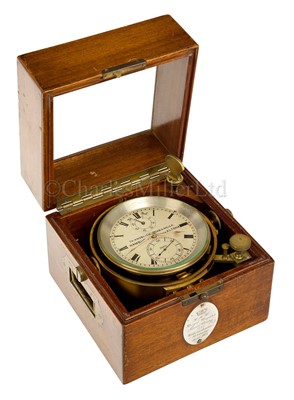5th Nov, 2019 11:00
Maritime and Scientific Models, Instruments & Art ('Superb')
101
[Z] AN HISTORICALLY INTERESTING TWO-DAY MARINE CHRONOMETER BY T.H. KNOBLICH, HAMBURG, CIRCA 1900 RECOVERED FROM AND USED AS A WARD ROOM CLOCK AT H.M.S. ROYAL RUPERT, WILHELMSHAVEN, GERMANY, APRIL 1945
AN HISTORICALLY INTERESTING TWO-DAY MARINE CHRONOMETER BY TH. KNOBLICH, HAMBURG, CIRCA 1900, RECOVERED FROM AND USED AS A WARD ROOM CLOCK AT H.M.S. ROYAL RUPERT, WILHELMSHAVEN, GERMANY, APRIL 1945
the 4in. silvered dial signed, inscribed and numbered Th Knoblich. Inhab: A. Meier Hamburg Früher Altona 2465, with gold main and blued secondary hands, fusee movement with Earnshaw’s escapement, standard balance with plain steel helical balance spring, spotted plates, contained within gimbal-mounted brass bowl stamped in the bottom 5715, the reverse with German national symbol 1939-1945 and M948 by winding hole, contained within two-tier glazed box with tipsy key and locking arm, with silver plate to front engraved with the naval crown and inscribed H.M.S. Royal Rupert Naval Party 1735 Wilhelmshaven, Germany, April 1945, approximately -- 7in. (17.5cm.) square
Provenance: Lt. Sinclair and thence by descent.
Germany's formal surrender of 8th May 1945 had been long anticipated before Hitler's suicide on 30th April. All that remained of the Kriegsmarine were two cruisers and a dozen or so destroyers, and many submarines and small craft. With German matelots wandering freely in increasing numbers, the allies sent in forces to maintain order. So, in April 1945, British Naval Party 1735 was sent in convoy to occupy Wilhelmshaven naval base ahead of the formal Kriegsmarine surrender. They re-named their section of it H.M.S. Royal Rupert for the duration of about two years. Ultimately some 200 vessels were crammed into the base and this chronometer is believed to have been recovered from one of the many u-boats. It served as the wardoom 'clock' and returned to Britain as a War souvenir in 1947. The Royal Navy has had several ships named 'Rupert' but Royal Rupert is unique and is presumably a nod to the friendlier Germany associated with the 17th Century Prince Rupert of the Rhine, son of Frederick V, Elector Palatine and nephew of Charles I.
AN HISTORICALLY INTERESTING TWO-DAY MARINE CHRONOMETER BY TH. KNOBLICH, HAMBURG, CIRCA 1900, RECOVERED FROM AND USED AS A WARD ROOM CLOCK AT H.M.S. ROYAL RUPERT, WILHELMSHAVEN, GERMANY, APRIL 1945
the 4in. silvered dial signed, inscribed and numbered Th Knoblich. Inhab: A. Meier Hamburg Früher Altona 2465, with gold main and blued secondary hands, fusee movement with Earnshaw’s escapement, standard balance with plain steel helical balance spring, spotted plates, contained within gimbal-mounted brass bowl stamped in the bottom 5715, the reverse with German national symbol 1939-1945 and M948 by winding hole, contained within two-tier glazed box with tipsy key and locking arm, with silver plate to front engraved with the naval crown and inscribed H.M.S. Royal Rupert Naval Party 1735 Wilhelmshaven, Germany, April 1945, approximately -- 7in. (17.5cm.) square
Provenance: Lt. Sinclair and thence by descent.
Germany's formal surrender of 8th May 1945 had been long anticipated before Hitler's suicide on 30th April. All that remained of the Kriegsmarine were two cruisers and a dozen or so destroyers, and many submarines and small craft. With German matelots wandering freely in increasing numbers, the allies sent in forces to maintain order. So, in April 1945, British Naval Party 1735 was sent in convoy to occupy Wilhelmshaven naval base ahead of the formal Kriegsmarine surrender. They re-named their section of it H.M.S. Royal Rupert for the duration of about two years. Ultimately some 200 vessels were crammed into the base and this chronometer is believed to have been recovered from one of the many u-boats. It served as the wardoom 'clock' and returned to Britain as a War souvenir in 1947. The Royal Navy has had several ships named 'Rupert' but Royal Rupert is unique and is presumably a nod to the friendlier Germany associated with the 17th Century Prince Rupert of the Rhine, son of Frederick V, Elector Palatine and nephew of Charles I.
Auction: Maritime and Scientific Models, Instruments & Art ('Superb'), 5th Nov, 2019
Download a Bid Form here
Main view and sale venue:
Olympia Auctions
25 Blythe Road
London
W14 0PD
Large object view
6 Imperial Studios
3-11 Imperial Road
London
SW6 2AG
Viewing
Saturday, 2nd November
(12pm-4pm)
Sunday, 3rd November
(12pm-4pm)
Monday, 4th November
(10am-5pm)
Tuesday, 5th November
(10am-11am)












